|
PREHISTORIC
REMAINS
AHU OR
BURIAL-PLACES
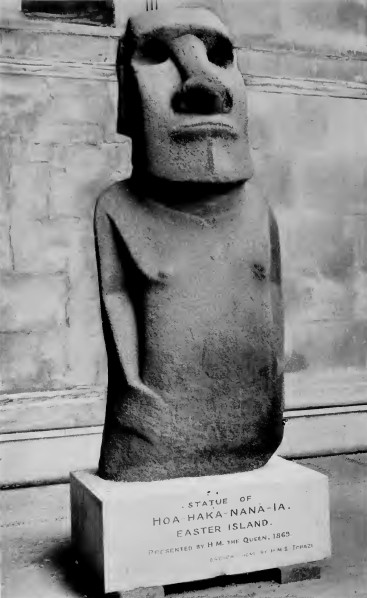 FIG. 31. STATUE
AT THE BRITISH MUSEUM.
For back of statue
see fig. 106.
FIG. 31. STATUE
AT THE BRITISH MUSEUM.
For back of statue
see fig. 106.
CHAPTER
XIII
PREHISTORIC
REMAINS
AHU OR
BURIAL-PLACES
Form of
the Easter Island Image Position and Number of the Ahu Design and
Construction of the Image Ahu Reconstruction and Transformation The
Semi-pyramid Ahu The Overthrow of the Images and Destruction of the
Ahu.
In many
places it is possible in the light of great monuments to reconstruct
the past.
In Easter Island the past is the present, it is impossible to escape
from it;
the inhabitants of to-day are less real than the men who have gone; the
shadows
of the departed builders still possess the land. Voluntarily or
involuntarily
the sojourner must hold commune with those old workers; for the whole
air
vibrates with a vast purpose and energy which has been and is no more.
What was
it? Why was it? The great works are now in ruins, of many comparatively
little
remains; but the impression infinitely exceeded anything which had been
anticipated, and every day, as the power to see increased, brought with
it a
greater sense of wonder and marvel. If we were to tell people at home
these
things," said our Sailing-master, after being shown the prostrate
images
on the great burial place of Tongariki, they would not believe us."
The
present natives take little interest in the remains. The statues are to
them
facts of every-day life in much the same way as stones or banana-trees.
Have
you no moai" (as they are termed) "in England? was asked by one boy,
in a tone in which surprise was slightly mingled with contempt; to ask
for the
history of the great works is as successful as to try to get from an
old woman
selling bootlaces at Westminster the story of Cromwell or of the
frock-coated
worthies in Parliament Square. The information given in reply to
questions is
generally wildly mythical, and any real knowledge crops up only
indirectly.
Anyone
who is able to go to the British Museum can see a typical specimen of
an Easter
Island statue, in the large image which greets the approaching visitor
from
under the portico (fig. 31). The general form is unvarying, and with
one
exception, which will be alluded to hereafter, all appear to be the
work of
skilled hands, which suggests that the design was well known and
evolved under
other conditions. It represents a half-length figure, at the bottom of
which
the hands nearly meet in front of the body. The most remarkable
features are
the ears, of which the lobe is depicted to represent a fleshy rope
(fig. 58),
while in a few cases the disc which was worn in it is also indicated
(fig. 59).
The fashion of piercing and distending the lobe of the ear is found
among
various primitive races.1 The tallest statues are over 30
feet, a
few are only 6 feet, and even smaller specimens exist. Those which
stood on the
burial-places, now to be described, are usually from 12 to 20 feet in
height,
and were surmounted with a form of hat.2
Position and Number of Ahu. In
Easter Island the problem of the disposal of the dead was solved by
neither
earth-burial nor cremation, but by means of the omnipresent stones
which were
built up to make a last resting-place for the departed. Such
burial-places are
known as "ahu," and the name will henceforth be used, for it
signifies a definite thing, or rather type of thing, for which we have
no equivalent.
They number in all some two hundred and sixty, and are principally
found near
the coast, but some thirty exist inland, sufficient to show that their
erection
on the sea-board was a matter of convenience, not of principle. With
the
exception of the great eastern and western headlands, where they are
scarce, it
is probably safe to say that, in riding round the island, it is
impossible to
go anywhere for more than a few hundred yards without coming across one
of
these abodes of the dead. They cluster most thickly on the little coves
and
their enclosing promontories, which were the principal centres of
population.
Some are two or three hundred yards away from the edge of the cliff,
others
stand on the verge; in the lower land they are but little above the
sea-level,
while on the precipitous part of the coast the ocean breaks hundreds of
feet
below.
It was
these burial-places, on which the images were then standing, which so
strongly
impressed the early voyagers and whose age and origin have remained an
unsolved
problem.
Ranu Raraku Ahu Kia-ori-ori
Ahu
Akahanga
Ahu Orpiri Ahu
Harι-o-ava

FIG. 32. AKAHANGA COVE AND NEIGHBOURING AHU
Portion of an image
still
standing
Rano Raraku, S. E.
face
Bases of fallen images

FIG. 33. AHU TONGARIKI, SEAWARD SIDE
During
the whole of our time on the island we worked on the ahu as way opened.
Those
which happened to lie near to either of our camps were naturally easy
of
access, but to reach the more distant ones, notably those on the north
shore,
involved a long expedition. Such a day began with perhaps an hour's
ride; at
noon there was an interval for luncheon, when, in hot weather, the
neighbourhood was scoured for miles to find the smallest atom of shade;
and the
day ended with a journey home of not less than two hours, during which
an
anxious eye was kept on the sinking sun. The usual method, as each ahu
was
reached, was for S. to dismount, measure it and describe it, while I
sat on my
pony and scribbled down notes; but in some manner or other every part
of the
coast was by one or both of us ridden over several times, and a written
statement made of the size, kind, condition, and name of each monument.
Unfortunately
there is in existence no large-scale plan of the coast, a need we had
to supply
as best we could; map of Easter Island there is none, only the crude
chart; the
efforts of our own surveyor were limited, by the time at his disposal,
to
making detailed plans of a few of the principal spots. The want is to
be
regretted geographically, but it does not materially affect the
archaeological
result. We were always accompanied by native guides in order to learn
local
names and traditions, and it was soon found necessary to make a point
of these
being old men; owing to the concentration of the remains of the
population in
one district, all names elsewhere, except those of the most important
places,
are speedily being forgotten. The memories of even the older men were
sometimes
shaky, and to get reasonably complete and accurate information the
whole of a
district had, in more than one case, to be gone over again with a
second
ancient who turned out to have lived in the neighbourhood in his youth
and
hence to be a better authority.
Original Design and
Construction of Image
Ahu. The burial-places
are not all of one type, nor all constructed to
carry statues; some also are known to have been built comparatively
recently,
and will therefore be described under a later section. The image ahu
are,
however, all prehistoric. They number just under a hundred, or over
one-third
of the whole.3 The figures
connected with them, of which traces still remain, were counted as 231,
but as
many are in fragments, this number is uncertain.
A typical
image ahu (fig. 36) is composed of a long wall running parallel with
the sea,
which, in a large specimen, is as much as 15 feet in height and 300
feet in
length; it is buttressed on the land side with a great slope of
masonry. The
wall is in three divisions. The main or central portion projects in the
form of
a terrace on which the images stood, with their backs to the sea; it is
therefore broad enough to carry their oval bed-plates; these measure up
to
about 10 feet in length by 8 feet or 9 feet in width, and are flush
with the
top of the wall. On the great ahu of Tongariki there have been fifteen
statues,
but sometimes an ahu has carried one figure only.
The wall
which forms the landward side of the terrace is continued on either
hand in a
straight line, thus adding a wing at each end of the central portion
which
stands somewhat farther back from the sea (fig. 41). Images were
sometimes
placed on the wings, but it was not usual. From this continuous wall
the
masonry slopes steeply till it reaches a containing wall, some 3 feet
high,
formed of finely wrought slabs of great size and of peculiar shape; the
workmanship put into this wall is usually the most highly finished of
any part
of the ahu. Extending inland from the foot of this low wall is a large,
raised,
and smoothly paved expanse. The upper surface of this, too, has an
appreciable
fall, or slope, inland, though it is almost horizontal, when compared
with the
glacis.
By the
method of construction of this area, vault accommodation is obtained
between
its surface pavement and the sheet of volcanic rock below, on which the
whole
rests. In the largest specimen the whole slope of masonry, measured
that is
from either the sea-wall of the wing or from the landward wall of the
terrace
to its farthest extent, is about 250 feet. Beyond this the ground is
sometimes
levelled for another 50 or 60 yards, forming a smooth sward which much
enhanced
the appearance of the ahu. In two cases the ahu is approached by a
strip of
narrow pavement formed of water-worn boulders laid flat, and bordered
with the
same kind of stone set on end; one of these pavements is 220 feet in
length by
12 feet in width, the other is somewhat smaller (fig, 93).
Head on its back Statue on its
front
Crown of
back
Portion of an image still standing

FIG. 34. AHU TONGARIKI, LANDWARD SIDE
With fifteen fallen statues.

FIG 35. AHU VINAPU
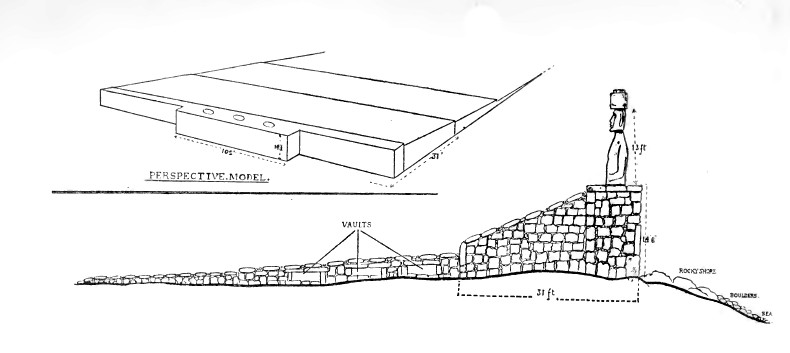
FIG. 36. DIAGRAM
OF IMAGE AHU
The
general principle on which the sea or main walls are constructed is
usually the
same, though the various ahu differ greatly in appearance: first comes
a row of
foundation blocks on which have been set upright the largest stones
that could
be found; the upper part of the wall is composed of smaller stones, and
it is
finished with a coping. The variety in effect is due to the difference
in
material used. In some cases, as at Tonga riki (fig. 33), the most
convenient
stone available has consisted of basalt which has cooled in fairly
regular
cubes, and the rows are there comparatively uniform in size; in other
instances, as at Ahu Tepeu on the west coast (fig. 37), the handiest
material
has been sheets of lava, which have hardened as strata, and when these
have
been used the first tier of the wall is composed of huge slabs up to 9
feet in
height. Irregularities in the shape and size of the big stones are
rectified by
fitting in small pieces and surmounting the shorter slabs with
additional
stones until the whole is brought to a uniform level; on the top of
this now
even tier horizontal blocks are laid, till the whole is the desired
height
(fig. 42). The amount of finish put into the work varies greatly: in
many ahu
the walls are all constructed of rough material; in others, while the
slabs are
untouched, the stones which bring them to the level and the cubes on
the top
are well wrought; in a very few instances, of which Vinapu (fig. 35) is
the
best example, the whole is composed of beautifully finished work.
Occasionally,
as at Oroi, natural outcrops of rock have been adapted to carry statues
(fig.
122).
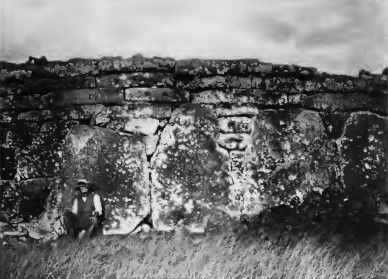
FIG. 37. AHU
TEPEU.
Part of seaward
wall showing large slabs
some of the stones forming upper courses
are wrought foundation-stones of canoe-shaped
houses.
The study
of the ahu is simplified by the fact that they were being used in
living memory
for the purpose for which they were doubtless originally built. They
have been
termed "burial-places," but burial in its usual sense was not the
only, nor in most cases their principal, object. On death the corpse
was
wrapped in a tapa blanket and enclosed in its mattress of reeds;
fish-hooks,
chisels, and other objects were sometimes included. It was then bound
into a
bundle and carried on staves to the ahu, where it was exposed on an
oblong
framework. This consisted of four corner uprights set up in the ground,
the
upper extremities of which were Y-shaped, two transverse bars rested in
the
bifurcated ends, one at the head, the other at the foot, and on these
transverse bars were placed the extremities of the bundle which wrapped
the
corpse. The description and sketch are based on a model framework, and
a
wrapped-up figure, one of the wooden images of the island, prepared by
the
natives to amplify their verbal description.4 At times,
instead of
the four supports, two stones were used with a hole in each, into which
a
Y-shaped stick was placed (fig. 38). While the corpse remained on the
ahu the
district was marked off by the pera, or taboo, for the dead; no fishing
was
allowed near, and fires and cooking were forbidden within certain marks
the
smoke, at any rate, must be hidden or smothered with grass. Watch was
kept by
four relatives, and anyone breaking the regulations was liable to be
brained.
The mourning might last one, two, or even three years, by which time
the whole
thing had, of course, fallen to pieces. The bones were either left on
the ahu,
or collected and put into vaults of oblong shape, which were kept for
the
family, or they might be buried elsewhere. The end of the mourning was
celebrated by a great feast, after which ceremony, as one recorder
cheerfully
concluded, Pappa was finished."
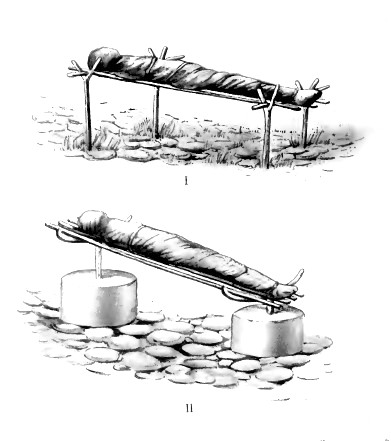
FIG. 38. METHOD
OF EXPOSING THE DEAD FROM
ILLUSTRATED DESCRIPTIONS.
Looked at
from the landward side, we may, therefore, conceive an ahu as a vast
theatre
stage, of which the floor runs gradually upwards from the footlights.
The back
of the stage, which is thus the highest part, is occupied by a great
terrace,
on which are set up in line the giant images, each one well separated
from his
neighbour, and all facing the spectator. Irrespective of where he
stands he
will ever see them towering above him, clear cut out against a
turquoise sky.
In front of them are the remains of the departed. Unseen, on the
farther side
of the terrace, is the sea. The stone giants, and the faithful dead
over whom
they watch, are never without music, as countless waves launch their
strength
against the pebbled shore, showering on the figures a cloud of mist and
spray.
Reconstruction and
Transformation. Those
which have been described are ideal image ahu, but not one now remains
in its
original condition. It is by no means unusual to find, even in the
oldest parts
now existing, that is in walls erected to carry statues, pieces of
still older
images built into the stonework; in one case a whole statue has been
used as a
slab for the sea-wall, showing that alteration has taken place even
when the
cult was alive (fig. 42). Again, a considerable number of ahu, some
thirteen in
all, after being destroyed and terminating their career as
image-terraces, have
been rebuilt after the fashion of others constructed originally on a
different
plan (fig. 39). This is a type for which no name was found: it is in
form that
of a semi-pyramid, and there are between fifty and sixty on the island,
in
addition to those which have been in the first place image-ahu (fig.
42). A few
are comparatively well made, but most are very rough. They resemble a
pyramid
cut in two, so that the section forms a triangle; this triangle is the
sea-wall; the flanking buttress on the land side is made of stones, and
is
widest at che apex or highest point, gradually diminishing to the
angles or
extremities. The greatest height, in the centre, varies from about 5
feet to 12
feet, and a large specimen may extend in length from 100 feet to 160
feet. They
contain vaults. In a few instances they are ornamented by broken pieces
of
image-stone, and occasionally by a row of small cairns along the top,
which
recall the position of the statues on the image-platform; for these no
very
certain reason was forthcoming, they were varyingly reported to be
signs of pera"
or as marking the respective right of families on the ahu. As
image-terraces
may be found reconstructed as pyramid ahu, the latter form of building
must
have been carried on longer than the former, and probably till recent
times,
but there is nothing to show whether or not the earliest specimens of
pyramid
ahu are contemporary with the great works, or even earlier.
Overthrow of the Images and
Destruction of
the Ahu. The only piece
of a statue which still remains on its bed-plate is the
fragment already alluded to at Tongariki (fig. 34). In the
best-preserved
specimens the figures lie on their faces like a row of huge nine-pins;
some are
intact, but many are broken, the cleavage having generally occurred
when the
falling image has come in contact with the containing wall at the lower
level. The
curious way in which the heads have not infrequently turned a
somersault while
falling and now lie face uppermost is shown in the eighth figure from
the
western end on Tongariki ahu (fig. 34).
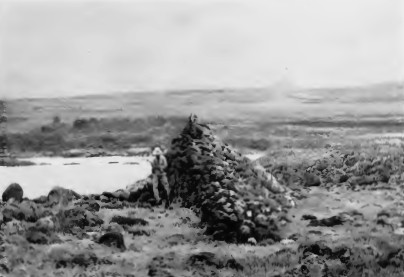
FIG. 39. A
SEMI-PYRAMID AHU.

FIG. 40. DIAGRAM
OF SEMI-PYRAMID AHU.
No one
now living remembers a statue standing on an ahu; and legend, though
not of a
very impressive character, has already arisen to account for the fall
of some
of them. An old man arrived, it is said, in the neighbourhood of
Tongariki, and
as he was unable to speak, he made known by means of signs that he
wished for
chicken-heads to eat; these were not forthcoming. He slept, however, in
one of
the houses there, and during the night his hosts were aroused by a
great noise,
which he gave it to be understood was made by his feet tapping against
the
stone foundations of the house. In the morning it was found that the
statues on
the great ahu had all fallen: it was the revenge of the old man. Such
lore is,
however, mixed up with more tangible statements to the effect that the
figures
were overthrown in tribal warfare by means of a rope, or by taking away
the
small stones from underneath the bed-plates, and thus causing them to
fall
forward. That the latter method had been used had been concluded
independently
by studying the remains themselves. It will be seen later, that other
statues
which have been set up in earth were deliberately dug out, and it seems
unnecessary to look, as some have done, to an earthquake to account for
their
collapse.
Moreover,
the conclusion that the images owed their fall to deliberate vandalism
during
internecine warfare is confirmed by knowledge, which still survives,
connected
with the destruction of the last one. This image stood alone on an ahu
on the
north coast, called Paro, and is the tallest known to have been put up
on a
terrace, being 32 feet in height. The events occurred just before
living
memory, and, like most stories in Easter Island, it is connected with
cannibalism.
A woman of the western clans was eaten by men of the eastern; her son
managed
to trap thirty of the enemy in a cave and consumed them in revenge; and
during
the ensuing struggle this image was thrown down (fig. 78). The oldest
man
living when we were on the island said that he was an infant at the
time; and
another, a few years younger, stated that his father as a boy helped
his
grandfather in the fight. It is not, after all, only in Easter Island
that
pleasure has been taken during war-time in destroying the architectural
treasures of the enemy.
While,
therefore, the date of the erection of the earliest image ahu is lost
in the
mists of antiquity, nor are we yet in a position to say when the
building
stopped, we can give approximately the time of the overthrow of the
images. We
know, from the accounts of the early voyagers, that the statues, or the
greater
number of them, were still in place in the eighteenth century; by the
early
part of the middle of the nineteenth century not one was standing.
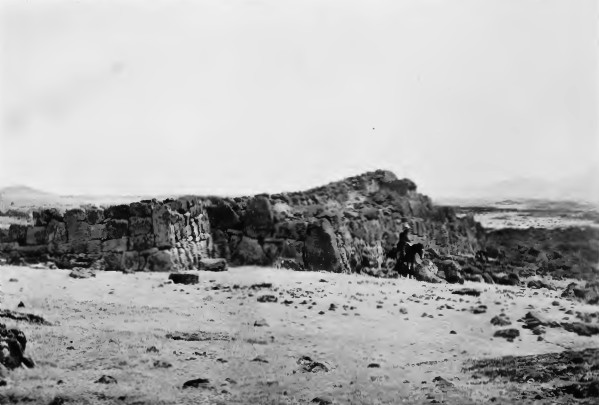
FIG. 41 AHU MAHATUA, SEAWARD SIDE
Image ahu, with
east wing clearly defined.
Landward side and centre converted to semi-pyramid form.
The
destruction of the ahu has continued in more modern days. A manager,
whose
sheep had found the fresh-water springs below high water, thinking they
were
injuring themselves by drinking from the sea, erected a wall round a
large part
of the coast to keep them from it. For this wall the ahu came in of
course most
conveniently; it was run through a great number and their material used
for its
construction. One wing of Tongariki has been pulled down to form an
enclosure
for the livestock. In addition to the damage wrought by man, the ocean
is ever
encroaching: in some cases part of an ahu has already fallen into the
sea, and
more is preparing to follow; statues may be found lying on their backs
in
process of descending into the waves (fig. 43). One row of images, on
the
extreme western edge of the crater of Rano Kao, which were visible,
although
inaccessible, at the time of the visit of the U.S.A. ship Mohican
in 1886, are now lying on the shore a thousand feet below.
As the result of these various causes the burial-places of Easter
Island are,
as has been seen, all in ruins, and many are scarcely recognisable;
only their
huge stones and prostrate figures show what they must once have been.
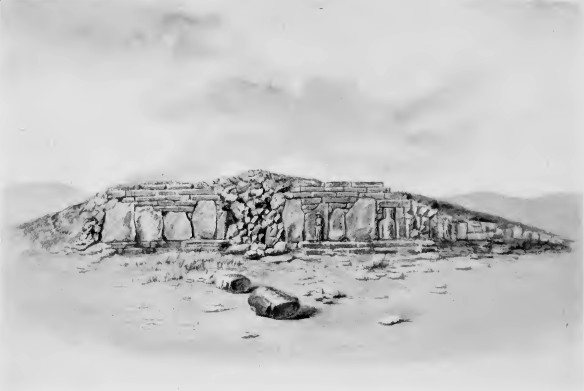
FIG. 42. AHU
MAITAKI-TE-MOA, SEAWARD SIDE.
An Image ahu
partially destroyed and changed
to semi-pyramid type. A statue from Raraku lies in foreground; another
statue
of different stone forms part of the main wall.
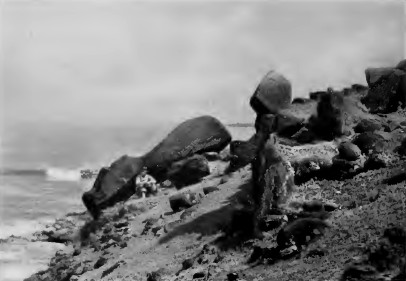
FIG. 43. AHU RUNGA-VAE, ON SOUTH COAST,
UNDERMINED BY THE SEA.
Statue has fallen
backwards
1 For an
illustrated description of the method of expanding the ear, see With a Prehistoric People, the Akikuyu of
British East Africa, p. 32.
2 A full
description of the statues is given in chap. xiv.
3 This
excludes some fifteen which may have carried statues, but about which
doubt
exists.
4 The body
was no doubt supported by staves, though they were dispensed with in
the model,
being unnecessary for the wooden figure.
|

